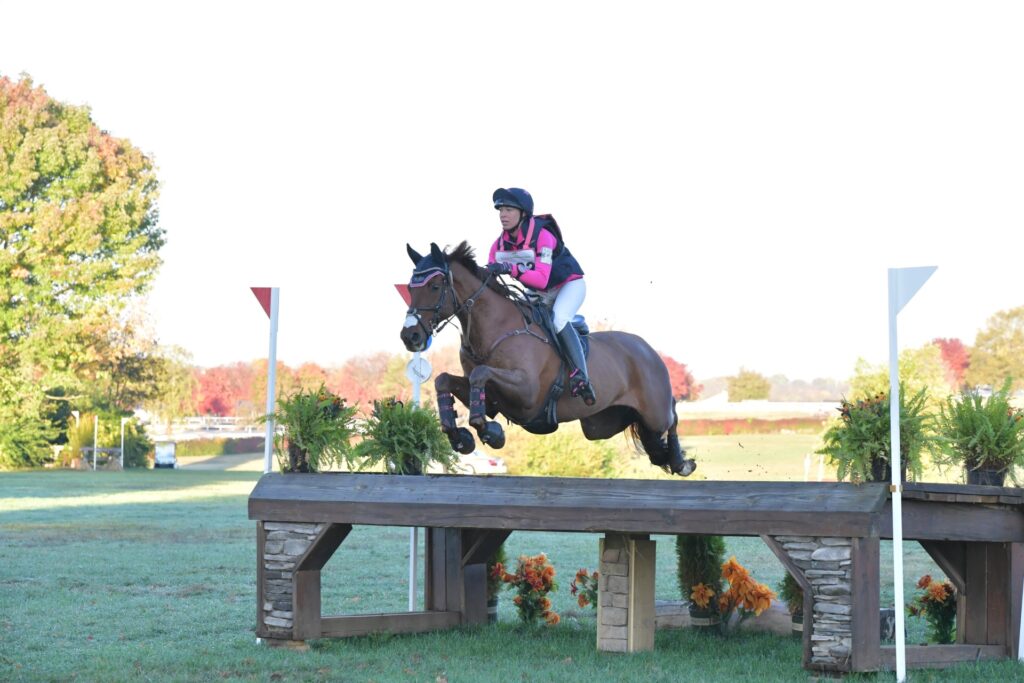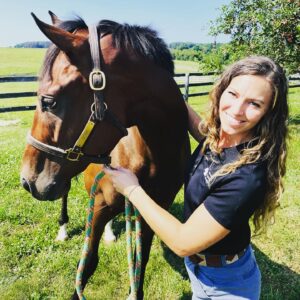
Madeline Backus knew Lynx, aka Baratheon, an 11-year-old chestnut Trakehner, was a quirky horse when he joined her family’s Colorado equestrian center in 2020. As they got to know one another, she came to appreciate Lynx’s playful personality and worked with him to get his brain and body lined up.
“From the moment I met him, I knew he was super talented,” said Backus. With that talent also came a few quirks.
While he loves to snatch treats from your pocket and will come when you call his name, he’s a grump when it comes to grooming and doesn’t like fuss. Having grown up in a herd, he learned to get along with others, but in Colorado, he prefers to keep a fence between himself and the other horses.
“He likes to play and bite and paw, and it just gets too much,” said Backus. “He gets along with everyone across the fence.”
But when that quirkiness extended into a problem with his breathing, she knew this promising horse needed more help.
What’s that funny noise?
Recognizing his raw talent, they headed to Florida for their first winter together to prepare for eventing competition, the triathlon of equestrian events, which includes dressage, cross country, and show jumping.
“When I first got him and started riding him, he wasn’t very fit – he hadn’t done much before,” said Backus.
Despite multiple rides during their first six months together, she quickly noticed a funny noise she’d not heard before when galloping and cantering in the arena.
A local veterinarian diagnosed Lynx with grade 4 left laryngeal hemiplegia, a condition that paralyzes cartilage in the windpipe. Horses with this diagnosis are called “roarers” because of the sounds produced by the restricted airway. Due to decreases in airflow, it can cause exercise intolerance. The disease is typically not life-threatening and can be treated with surgery.
Veterinarians approved Lynx to continue his conditioning at a beginner level, gently getting him used to the routines of eventing competition while planning for surgery later in the year.
Back home in Colorado, in the fall of 2021, Lynx underwent prosthetic laryngoplasty, aka tie-back surgery, at Colorado State University’s Johnson Family Equine Hospital. This is the most common procedure to treat this disease and involves anchoring the paralyzed arytenoid (dynamic laryngeal cartilage, aka flapper) to the cricoid cartilage (stable cartilage) open position, traditionally with suture.
Lynx took time off and returned to training in Florida the following spring. Unfortunately, the familiar roaring sound returned when Backus and Lynx started riding again. The pair continued to work together, and remarkably, Lynx performed well and rose to the next level.

Surgical expertise when tie-back fails
In September 2022, Backus brought Lynx back to CSU. This time, they met with CSU equine surgeon and faculty member Dr. Lauren Luedke, who brought experience with new surgical implants for treating horses with laryngeal hemiplegia.

“Tie-back surgery is standard for this condition, but it doesn’t always work how we want; it is typically not the procedure that fails, but rather the cartilage is softer than the suture used; therefore, the cartilage itself can fail,” said Luedke. “A handful of people across the US and Europe and I have been working on a solution to solve that problem.”
Backus shared her concerns about a second procedure, wondering if it would be successful.
“I was grateful for everyone talking me through it when I wasn’t quite sure,” said Backus. “Dr. Luedke explained the difference in the new surgery technique using implants and how it would go; her input helped me decide to proceed with the second surgery.”
Luedke’s clinical research involves mechanical testing of titanium implants to bolster the suture construct. Specifically, she has been testing an implant called the Tie-Bolt, which acts as a tunnel for the suture to pass through in the arytenoid cartilage (flapper). She also uses other implants, including a “button” that acts like a toggle to prevent sutures from cutting through, and a suture anchor, which screws into the arytenoid cartilage with a strand of suture that passes through the top of the implant, preventing any interaction of the suture with the cartilage.
During the second procedure, Dr. Luedke used the Tie-Bolt implant to improve the opening in Lynx’s airway. He recovered well from the second surgery, resting again over the winter.
“Surgery went well, and Lynx was a model patient for the procedure, which is performed standing with just sedation and local anesthesia. It’s more challenging the second time you go in there because there is quite a lot of scar tissue that forms with surgery. The cartilage was soft, which I suspect is why the tie-back failed the first time. However, the implants offer added protection. Since surgery, Lynx has really been thriving; it’s always so rewarding when we get to see our patients excel as the athletes we know they can be,” said Luedke.

Rising through the ranks
In the spring of 2023, the team returned to Florida to prepare for competition.
“I could feel the difference right away; it was amazing,” said Backus. “It’s helped with his anxiety and just overall, not just performance-wise, but mentally too.”
Throughout the 2023 season, Lynx quickly moved up levels, outpacing his partner’s expectations.
“It’s very hard to find a horse that is so strong in all three phases; the judges love him,” said Backus.
Knowing his talent, she expected to compete at the preliminary level that season and get some experience there, but he quickly moved beyond that. By October, the team was easily competing at the intermediate level.
“We have pretty high hopes for him,” said Backus. “He’s shown us that he’s pretty special, and now he has no limitations!”